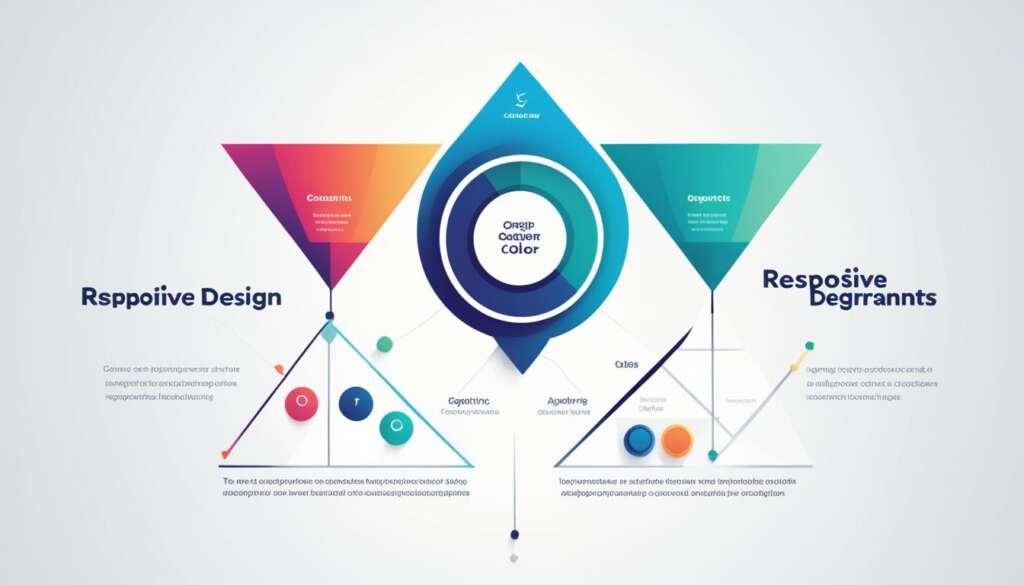Table of Contents
In today’s digital landscape, it is essential for designers to consider the variety of devices users may use to access websites. Responsive design and adaptive design are two approaches that aim to cater to different screen sizes and user needs. With the increasing amount of mobile traffic and the importance of user experience, it is crucial to understand the differences between responsive and adaptive design and choose the best approach for your website.
What is Responsive Design?
Responsive design is an approach that enables website content to adapt to the user’s screen size and adjust accordingly. This is achieved through the use of CSS media queries, which specify target device types and set breakpoints for layout changes. With responsive design, a single flexible layout is created, ensuring that website elements are displayed properly across different screens. This approach provides content flexibility, allowing it to meet various user needs and browsing styles.
One of the key techniques used in responsive design is CSS media queries. These queries allow designers to apply different styles to a webpage based on the user’s device specifications, such as screen size, resolution, and orientation. By defining specific breakpoints, designers can determine when and how the layout should change to optimize the user experience.
This flexibility is achieved by making the website’s elements responsive through the use of relative units, such as percentages, rather than fixed units like pixels. This allows the content to scale and reposition itself dynamically according to the screen size. Responsive design ensures that the website is accessible and user-friendly on various devices, including smartphones, tablets, and desktop computers.
How Responsive Design Works:
- The user accesses a website on their device.
- The website’s CSS media queries detect the screen size and other device parameters.
- The CSS styles defined for that specific device are applied, adjusting the layout and content accordingly.
- The website is displayed in a user-friendly manner, ensuring optimal readability and navigation.
Responsive design ensures that a website’s layout and content adapt to the user’s screen size, providing an optimal browsing experience across different devices.
With responsive design, websites can deliver a consistent and seamless user experience regardless of the device being used. Whether users access the website on their smartphones while on the go or on their desktop computers at work, they can enjoy a visually appealing and functional website that adapts to their needs.
What is Adaptive Design?
Adaptive design is a web design approach that involves creating multiple layout versions specifically tailored for different screen sizes, orientations, and device types. With adaptive design, a website is equipped with predetermined display options that adapt to the user’s device parameters.
Unlike responsive design, where the content behaves according to predefined rules, adaptive design grants designers more control over the end result. This allows for a highly tailored user experience that caters to the unique characteristics of each device.
When a user accesses an adaptive website, the system detects the device’s parameters, such as screen size and orientation, and serves the layout that has been designed specifically for that screen. This ensures that users have an optimized viewing experience, no matter the device they are using.
Adaptive design grants designers more control over the user experience on different devices, providing highly tailored layout versions.
This approach is particularly beneficial for websites that require precise control over how their content is presented on various devices. Designers can create different layouts to suit specific devices, taking into account factors such as screen size, resolution, and browsing capabilities.
Benefits of Adaptive Design:
- Offers highly targeted and optimized experiences for different devices
- Provides more control over layout and content presentation
- Enables easy integration of ads and tailored content placement
- Ensures faster load times for optimized user experiences
Examples of Adaptive Design:
One example of adaptive design in action is Amazon. The e-commerce giant utilizes adaptive design to offer different layouts for desktop and mobile users. This ensures that the browsing experience is optimized for each device, delivering a seamless shopping journey.
Another use case for adaptive design is when retrofitting existing websites. Adaptive design allows companies to update their websites and provide tailored user experiences without the need for a complete redesign.
Pros and Cons of Responsive Web Design
Responsive web design has gained popularity due to its numerous advantages. It provides an easy implementation process, making it accessible even to individuals without advanced coding skills. Thanks to drag-and-drop website builders and customizable themes, creating a responsive design has become a user-friendly experience. This flexibility has contributed to the widespread use and recognition of responsive design in the field of user experience (UX) design and development.
One of the main benefits of responsive design is its ability to efficiently utilize screen real estate. By adjusting the layout to fit different screen sizes, responsive websites ensure an optimal viewing experience for users across devices. This adaptability eliminates the need for separate layouts for each device type, saving time and effort in design and maintenance.
The easy implementation process of responsive design also facilitates faster website development and launch times. With pre-existing templates and frameworks, designers can swiftly create responsive websites, allowing businesses to establish an online presence quickly. Moreover, responsive design is favored by search engines, as it ensures a consistent user experience across different devices, contributing to better search engine rankings.
However, responsive design does have its limitations. Creating a single layout for all devices may result in fewer targeted experiences for specific screens or orientations. Designers must carefully plan and test the responsiveness of their websites to ensure consistent usability. Additionally, since responsive designs adjust based on screen size, the use of images and media may need special consideration to ensure optimal display across devices.
Responsive web design offers a flexible and user-friendly approach to ensure a visually appealing website across various devices and screen sizes. Implementing responsive design has become more accessible, resulting in faster development and better search engine visibility. However, careful planning is required to maintain consistent usability and avoid potential limitations.
Pros of Responsive Design:
- Easy implementation for individuals without advanced coding skills
- Efficient use of screen real estate
- Adjusts layout to fit different screen sizes
- Requires less maintenance and faster design and launch times
- Better search engine rankings
Cons of Responsive Design:
- Potential for fewer targeted experiences on specific screens or orientations
- Requires careful planning and testing
- Special consideration for optimal media display
Pros and Cons of Adaptive Web Design
Adaptive web design offers precise control over the layout for each screen size, resulting in tailored user experiences. It allows for easier integration of ads and is useful for retrofitting existing websites. Adaptive sites tend to load faster, providing a high level of consistency in the user experience.
On the downside, adaptive design requires more work and expertise to implement and maintain. It may not cover all possible screen sizes, and users accessing the site on unsupported devices may experience issues. Moreover, adaptive design can be more expensive and less popular compared to responsive design.
Let’s take a closer look at the pros and cons of adaptive web design:
| Pros | Cons |
|---|---|
|
|
Despite its drawbacks, adaptive design offers unique advantages, such as precise control over layout and faster load times, that may make it a preferred choice for certain websites. However, it’s important to weigh the pros and cons carefully to make an informed decision based on your specific needs.
Responsive Design: Examples and Use Cases
Responsive design is a widely adopted approach in various industries, allowing websites to adapt and provide an optimal user experience across different devices. Here are some examples of businesses that have successfully implemented responsive design:
Los Sundays
Los Sundays, a popular tequila brand, has embraced responsive design to ensure their website looks stunning on both desktop and mobile screens. By utilizing the principles of responsive design, Los Sundays has achieved a seamless and visually appealing user interface, regardless of the device used to access their website.
Slam Jam
Slam Jam, an online apparel shop, exemplifies the benefits of responsive design by offering a smooth transition between different screen sizes. Their responsive website adjusts the number of product columns and optimizes the menu, providing a seamless browsing experience for customers across devices.
Here Design
Here Design, a creative studio, showcases the power of responsive design through their website. Not only does their page adapt effortlessly to various screen sizes, but it also loads quickly and presents content with stunning visual effects. This demonstrates how responsive design can create a consistent and engaging user experience on any device.
These examples highlight the versatility and effectiveness of responsive design in delivering a user-friendly experience across different devices and screens. By investing in responsive design, businesses can ensure that their websites remain aesthetically pleasing, functional, and accessible to a wide range of users.
Adaptive Design: Examples and Use Cases
Adaptive design is widely embraced by businesses seeking to provide tailored user experiences for specific devices or screen sizes. One notable example is Amazon, the renowned e-commerce giant. Amazon employs adaptive design to deliver different layouts for desktop and mobile users, ensuring optimal browsing experiences across devices. By leveraging adaptive design, companies can create personalized experiences based on user data and preferences, optimizing content and ad placements specific to each device.
Adaptive design is particularly valuable for businesses with existing websites that require mobile optimization. This approach allows for the seamless transition of user experiences across devices, enhancing accessibility and user engagement. By adopting adaptive design, companies can cater to the diverse needs and expectations of their users, resulting in better conversion rates and customer satisfaction.
Amazon’s Adaptive Design: Screenshots
| Desktop Layout | Mobile Layout |
|---|---|
“Adaptive design allows companies to deliver highly targeted experiences based on user data, preferences, and individual devices.”
With adaptive design, businesses can effectively optimize their websites for various devices, ensuring that users have a seamless and tailored experience regardless of the screen size or orientation. By utilizing adaptive design principles, companies can elevate their brand image, improve customer satisfaction, and drive conversions across platforms.
Conclusion
When it comes to website design, choosing the right approach between responsive and adaptive design is essential. Both have their strengths and weaknesses, making it crucial to consider the specific needs of your website.
Responsive design is the more popular option, offering easier implementation and flexibility for future device releases. With responsive design, your website will automatically adjust its layout and content according to the user’s screen size. This ensures a seamless user experience across different devices, from desktops to smartphones.
On the other hand, adaptive design provides precise control over layouts and can result in faster load times. This approach involves creating multiple ready-to-go layouts for different screen sizes and device types. Adaptive design allows you to tailor the user experience for each category, ensuring optimized content and design elements.
When deciding between responsive and adaptive design, consider factors such as your target audience, budget, and design requirements. Responsive design is ideal for those who prioritize easy implementation and future scalability. Alternatively, adaptive design is suitable for businesses seeking more control over layouts and faster load times.
Ultimately, the goal is to create a user-friendly website that delivers an optimal experience across different devices. Whether you choose responsive or adaptive design, ensure that your chosen approach aligns with your website’s goals, target audience, and overall design strategy.
FAQ
What is the difference between responsive design and adaptive design?
Responsive design allows website content to respond to the user’s screen size and adjust accordingly, while adaptive design involves creating multiple ready-to-go layouts for different screen sizes and device types.
How does responsive design work?
Responsive design uses CSS media queries to specify target device types and set breakpoints, which determine when the layout should change. It creates a single layout that adapts to various screen sizes and user needs.
How does adaptive design work?
Adaptive design detects the device parameters when a user accesses the website and serves the layout specifically designed for that screen. It allows designers to have control over the user experience on different devices.
What are the advantages of responsive web design?
Responsive web design is relatively easy to implement, widely recognized by UX designers and developers, and allows for efficient use of screen real estate. Responsive websites require less maintenance and can be faster to design and launch.
What are the advantages of adaptive web design?
Adaptive web design offers precise control over the layout for each screen size, resulting in tailored user experiences. It allows for easier integration of ads and tends to load faster, providing a high level of consistency in the user experience.
What are some examples of responsive design use cases?
Los Sundays, a tequila brand, Slam Jam, an online apparel shop, and Here Design showcase responsive design examples that look great and perform well on different devices.
What are some examples of adaptive design use cases?
Amazon utilizes adaptive design to offer different layouts for desktop and mobile users. This allows for an optimal browsing experience and personalized experiences based on user data and preferences.
How do I choose between responsive and adaptive design?
The choice between responsive and adaptive design depends on specific needs such as target audience, budget, and design requirements. Responsive design is easier to implement and offers flexibility, while adaptive design provides precise control and faster load times.
What is the goal of responsive and adaptive design?
The goal of both responsive and adaptive design is to create user-friendly websites that deliver optimal experiences across different devices.













